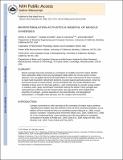Microstimulation Activates a Handful of Muscle Synergies
Author(s)
Overduin, Simon A.; d’Avella, Andrea; Carmena, Jose M.; Bizzi, Emilio
DownloadBizzi_Microstimulation actives.pdf (2.001Mb)
PUBLISHER_CC
Publisher with Creative Commons License
Creative Commons Attribution
Terms of use
Metadata
Show full item recordAbstract
Muscle synergies have been proposed as a mechanism to simplify movement control. Whether these coactivation patterns have any physiological reality within the nervous system remains unknown. Here we applied electrical microstimulation to motor cortical areas of rhesus macaques to evoke hand movements. Movements tended to converge toward particular postures, driven by synchronous bursts of muscle activity. Across stimulation sites, the muscle activations were reducible to linear sums of a few basic patterns—each corresponding to a muscle synergy evident in voluntary reach, grasp, and transport movements made by the animal. These synergies were represented nonuniformly over the cortical surface. We argue that the brain exploits these properties of synergies—postural equivalence, low dimensionality, and topographical representation—to simplify motor planning, even for complex hand movements.
Date issued
2012-12Department
Massachusetts Institute of Technology. Department of Brain and Cognitive Sciences; McGovern Institute for Brain Research at MITJournal
Neuron
Publisher
Elsevier
Citation
Overduin, Simon A., Andrea d’ Avella, Jose M. Carmena, and Emilio Bizzi. “Microstimulation Activates a Handful of Muscle Synergies.” Neuron 76, no. 6 (December 2012): 1071–1077.
Version: Author's final manuscript
ISSN
08966273
1097-4199